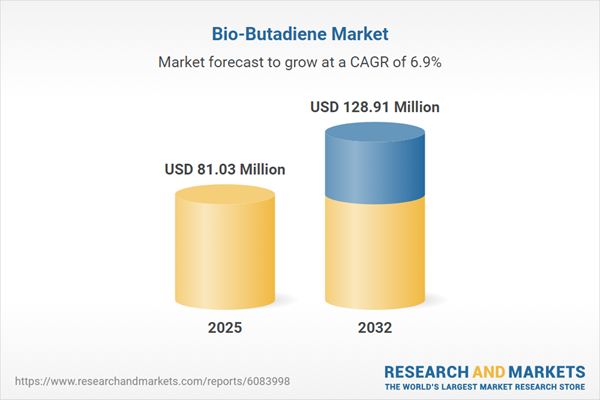Speak directly to the analyst to clarify any post sales queries you may have.
The bio-butadiene market is seeing a strategic shift as chemical producers worldwide prioritize sustainability, emissions reduction, and robust supply chains. Navigating this transformation is critical for senior leaders seeking competitive advantage amid evolving regulations and technical innovation.
Market Snapshot: Bio-Butadiene Market Growth and Opportunity
The global bio-butadiene market expanded from USD 75.76 million in 2024 to USD 81.03 million in 2025 and is forecast to reach USD 128.91 million by 2032, reflecting a CAGR of 6.87%.
Tighter greenhouse gas regulations and a gradual decline in fossil feedstock reliance are elevating the market importance of bio-butadiene. Manufacturers are increasingly motivated to adopt alternatives that satisfy sustainability criteria while integrating seamlessly with legacy infrastructure and maintaining reliable performance and cost benchmarks.Scope & Segmentation of the Bio-Butadiene Market
This analysis presents an in-depth assessment for executives shaping investments, partnerships, and operational models, with segmentation designed for clear decision impact.
- Applications: Encompasses resins such as Acrylonitrile Butadiene Styrene and Styrene Acrylonitrile, as well as synthetic rubber types including Butadiene Rubber, Nitrile Butadiene Rubber, and Styrene Butadiene Rubber. Each application group addresses unique requirements for strength, elasticity, and chemical resistance across major industries.
- Sources: Draws on biobutanol and bioethanol as primary raw materials, offering flexibility in feedstock strategy and enabling adaptation to regional resource strengths and regulatory environments.
- End Uses: Covers automotive, construction, and consumer goods, sectors actively seeking sustainable alternatives for performance and environmental compliance.
- Technologies: Involves catalytic cracking and catalytic dehydration processes. These pathways are central to scalable bio-butadiene production, supporting integration into both new facilities and retrofitted plants.
- Purity Grades: Includes chemical grade, polymer grade, and ultra-high purity bio-butadiene. Tailoring purity to specific downstream processes ensures application suitability and regulatory conformity.
- Regions: Market opportunities are distributed across the Americas (covering North, Central, and South America), Europe, Middle East & Africa, and Asia-Pacific. This regional breakdown reflects supply and demand dynamics, infrastructure maturity, and evolving policy landscapes.
- Companies: Key participants include Braskem S.A., Genomatica, Inc., Butamax Advanced Biofuels LLC, Versalis S.p.A., Global Bioenergies S.A., Gevo, Inc., Anellotech, Inc., LyondellBasell Industries N.V., BASF SE, and Amyris, Inc. Major firms invest in technology development and feedstock alliances to strengthen market positions.
Key Takeaways for Bio-Butadiene Stakeholders
- Bio-butadiene supports measurable improvements in sustainability by enabling the use of renewable feedstocks and helping end users align with evolving emissions regulations globally.
- Emerging catalytic dehydration and cracking advances improve operational throughput and support compatibility with various manufacturing infrastructures.
- Government incentives and adjustments in carbon pricing policies are reshaping cost models and driving swifter adoption of bio-butadiene, especially where local mandates prioritize low-carbon chemicals.
- Diversification of feedstock sources reduces exposure to price fluctuations and supply interruptions, delivering improved business continuity for manufacturers and downstream sectors.
- Strategic collaborations among technology licensors, feedstock suppliers, and converters expand innovation and adaptability, reinforcing market readiness for future shifts.
- Segmentation by application, technology, feedstock, and purity enables market participants to develop strategies tailored to regulatory and operational requirements unique to each geography and sector.
Impact of Tariffs and Global Supply Chain Realignment
Recent U.S. tariffs imposed on imported bio-butadiene and precursor chemicals are prompting companies to reassess procurement strategies. Some manufacturers are favoring local supply agreements or co-location to mitigate cost pressures, while regional suppliers in South America and Asia-Pacific are capturing increased demand. These adjustments highlight the need for organizations to strengthen geographically diverse sourcing networks and foster resilient domestic feedstock agreements, affecting trade patterns and pricing throughout the value chain.
Research Methodology & Data Sources
The report leverages a mixed-methods research framework, integrating structured interviews across the value chain with comprehensive secondary review of industry sources and policy documents. Scenario modeling and expert validation panels ensure that findings remain actionable and robust under changing regulatory and market conditions.
Why This Report Matters to Bio-Butadiene Market Leaders
- Delivers the full context of market trends, regulatory shifts, and disruptive technologies to inform executive-level strategic planning and risk management.
- Clarifies granular segment opportunities and competitive dynamics to support investment prioritization and operational agility across diverse regions and end-use sectors.
- Enables supply chain resilience by illuminating emerging partnership models, tariff impacts, and technology adoption that safeguard long-term competitiveness.
Conclusion
Bio-butadiene is positioned at the intersection of industry decarbonization, policy change, and technical progress. This strategic market analysis provides industry leaders with the insights needed to align initiatives for sustainable growth and market leadership.
Table of Contents
3. Executive Summary
4. Market Overview
7. Cumulative Impact of Artificial Intelligence 2025
Companies Mentioned
The companies profiled in this Bio-Butadiene market report include:- Braskem S.A.
- Genomatica, Inc.
- Butamax Advanced Biofuels LLC
- Versalis S.p.A.
- Global Bioenergies S.A.
- Gevo, Inc.
- Anellotech, Inc.
- LyondellBasell Industries N.V.
- BASF SE
- Amyris, Inc.
Table Information
| Report Attribute | Details |
|---|---|
| No. of Pages | 192 |
| Published | November 2025 |
| Forecast Period | 2025 - 2032 |
| Estimated Market Value ( USD | $ 81.03 Million |
| Forecasted Market Value ( USD | $ 128.91 Million |
| Compound Annual Growth Rate | 6.8% |
| Regions Covered | Global |
| No. of Companies Mentioned | 11 |









